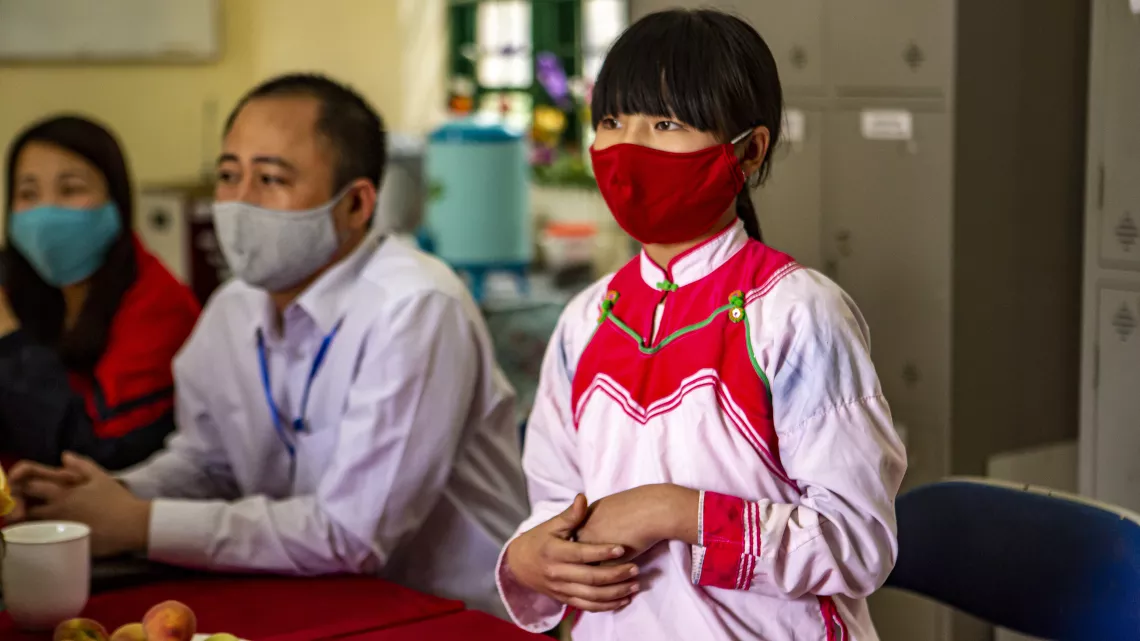Ethnic minority education in Viet Nam: challenges and opportunities during COVID-19 outbreak
With the promise of school re-opening for Viet Nam, I wanted to see for myself the preparations underway to ensure schools are safe and welcoming for children.

- Available in:
- English
- Tiếng Việt
With the promise of school re-opening for Viet Nam, I wanted to see for myself the preparations underway to ensure schools are safe and welcoming for children. And what a stunning drive it was to Sapa District. Around every corner the sheer beauty of the country was on glorious display.
Nestled in the foothills of the Fansipan, we arrived to an open gate but missing were the smiles, the beaming faces, the noise that made previous visits to schools such a joy. I wanted to visit Lao Cai schools because the education staff there are innovative, promoting advancements in their schools.

Lao Cai shares a border with China so it was impacted early by the COVID outbreak. By the 3rd of February, schools across Viet Nam were closed, the window for preparation considerably shorter than for those countries yet to be touched by the tentacles of the spreading disease.
The excitement around the promise of school re-opening was evident from all present. It was heartwarming to see the degree to which students missed the face to face learning with teachers – as well as teachers missing the classrooms filled with children. And everyone missed spending time with friends and colleagues. From the outset, the provincial Department of Education and Training and local school managers were determined to reach every child with ongoing learning, but the desire to implement distance learning proved to be much more challenging than anticipated in a region with high poverty rates and where very few families have devices and can afford internet at home.

In a world ever so connected, Lao Cai province stands out with its mountainous terrain where the equitable access to internet has not yet been achieved; where the families and even the teachers do not have devices, unable to access the kind of platforms that were supporting other children across Viet Nam to remain connected on-line.
Struck by the intelligence and charm of Dung, a 14-year-old from the H’mong people, I listened as she explained her experience. “The hardest part of online learning is that none of us have internet or WiFi at home. So my elder brother and I have had to walk to the nearest preschool which is one kilometer away from my house to connect on their WiFi and download the learning materials from the teachers. None of my classmates nor friends in the neighborhood have internet connection,” she said.
In fact, only 15% of children in this area have devices – exposing a dramatic digital divide – between the children that have and those children that do not. And it is the impact of that divide that we must urgently address. Children without devices, without internet simply did not benefit from the online learning. The digital divide equals = a learning divide – one that will only grow as education will increasingly require children to have digital skills and literacy. That chasm in learning equals a chasm in future earning potential – and if we do not act today to bring the divide it will only widen. We need savvy industry leaders to help ensure access to devices and to WiFi at home. The future economic growth of Viet Nam depends on every child having every opportunity, having equal opportunities to learn, to grow to develop. Dung could match any child I have met in HCMC or Hanoi – but my fear is that she and her classmates will, unfairly, be left behind unless we can address the divide.
To overcome the technological challenges, some teachers and school volunteers had to walk or drive long distance on the winding roads to reach the village heads who in turn helped distribute learning material and assignments to the students living in their communities. Such dedication – a wonderful testimony to the priority given to education for all in this region.
Trung Chai Ethnic Minority Semi-Boarding Lower Secondary School has a little over 300 students. According to the Principal Mr Tho, only 3% of the students could learn online in an interactive way such as Zoom, with less than one in five able to utilize non-interactive ways such as Zalo or Facebook. Two thirds of the students relied on hand distributed homework papers from the village heads due to limited access to internet and devices.
“With online learning, sometimes I can understand but sometimes it is challenging, especially when I have questions and need more explanations from the teachers. No one is in front of me to answer my questions,” explained another student named Dung who is also 14 years old.
Despite numerous challenges, the ethnic minority students have demonstrated their thirst for knowledge and cherish their dreams for a better future. Dung is also a member of the student-led Social Innovation Club that offers an experimental and learning space for students to nurture and innovate ideas to protect the environment, among others. Dung showed me the brocade fabric that she has made, and she is passionate about preserving the cultural identity of the traditional outfits of the H’Mong people.

Với sự hỗ trợ của các đối tác như SAP, UNICEF Việt Nam đã khởi xướng từ năm 2019 một chương trình xóa mù công nghệ sẽ được đưa vào chương trình giảng dạy và chương trình đào tạo của giáo viên, hướng tới những khu vực khó khăn như Sapa, với tỷ lệ cao trẻ em trai và gái dân tộc thiểu số. Đại dịch COVID thách thức chúng ta nhưng cũng đem lại những cơ hội mới. Thôi thúc trước những khó khăn trong học tập trực tuyến của học sinh, UNICEF đang vận động đầu tư và ưu tiên hỗ trợ thiết bị điện tử và kết nối internet cho tất cả mọi người, đặc biệt là vùng nông thôn và khó khăn. Mục đích cuối cùng là chúng ta cần có một nền tảng giáo dục được sử dụng trên toàn quốc, một chương trình giảng dạy kỹ năng số và xóa mù công nghệ số từ mẫu giáo đến lớp 12. Đây cũng là tầm nhìn tương lai của Bộ Giáo dục và Đào tạo Việt Nam. Từ đó, Bộ Giáo dục và Đào tạo, UNICEF và các đối tác sẽ xây dựng những công cụ học tập – từ video đến các ứng dụng, các khóa học chuyên môn – lồng ghép phát triển kỹ năng giải quyết vấn đề và kỹ năng phân tích. Chúng ta cần thay đổi trên quy mô lớn vì mọi trẻ em, đặc biệt là trẻ em gái. Hãy đồng hành và chung tay cùng chúng tôi bạn nhé?




